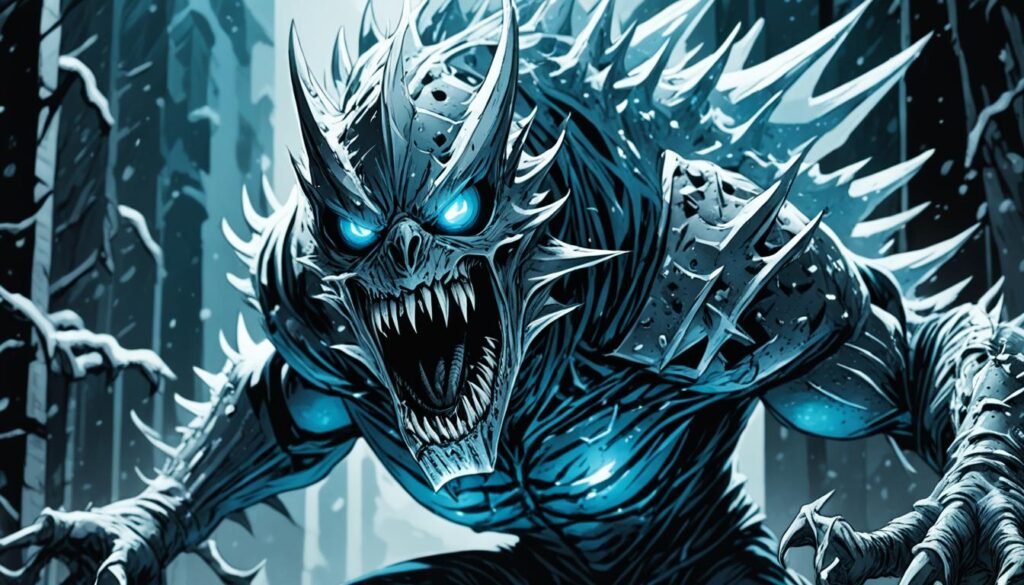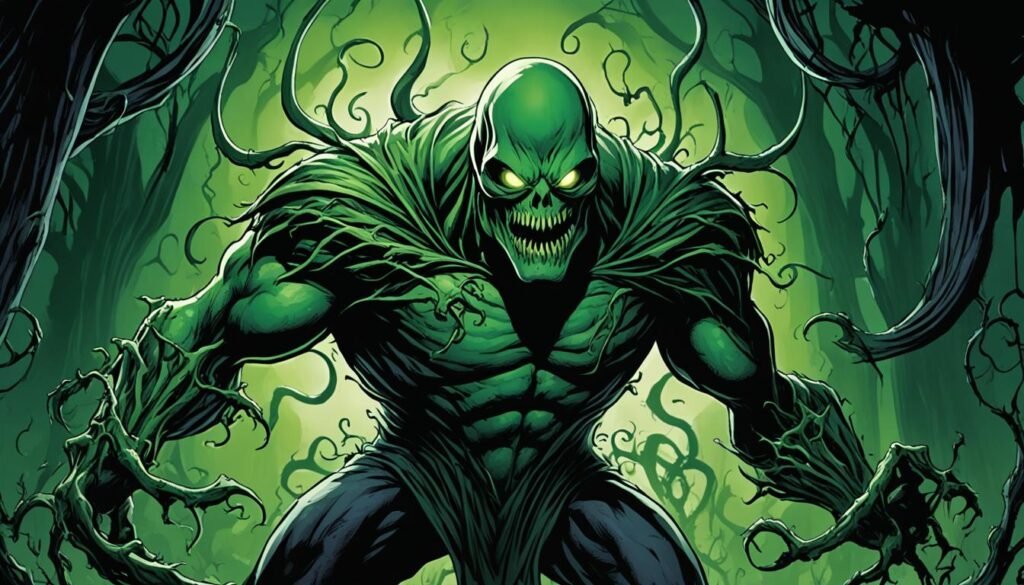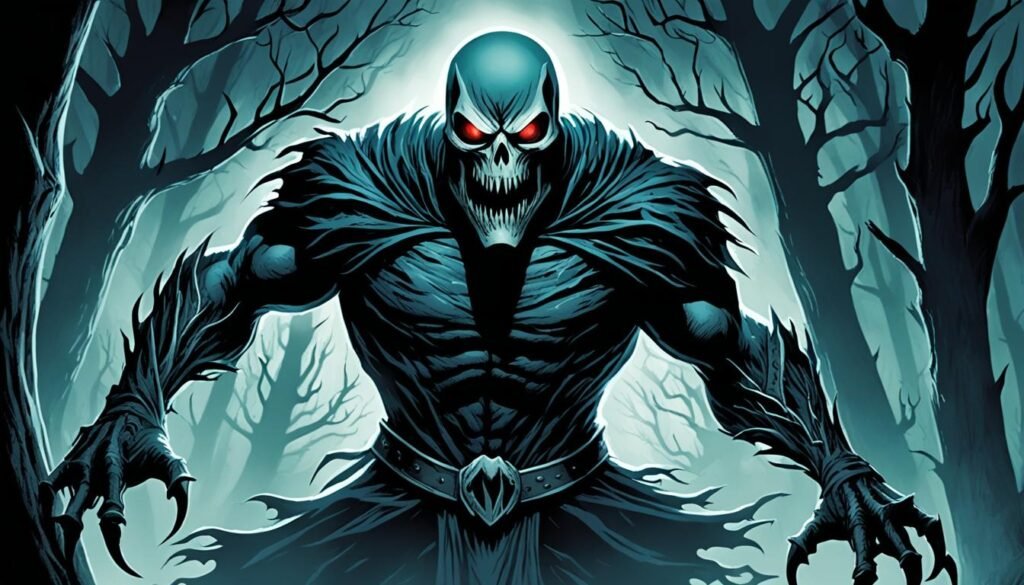In the heart of the Philippine archipelago, a frightening figure from folklore walks at night. He is seeking vengeance and spreading disease. Pugot, a headless, ape-like creature, is Filipinos’ symbol of fear against sickness and plague. This nightmarish entity with its decaying, switching shape is one of the most feared in all Philippine mythology.
The tales of Pugot have been told for generations on the islands. From mouth to mouth, stories of the creature’s terrifying look and its ability to spread new diseases silently have terrified many Filipinos. This makes it a key figure in Philippine urban legends and supernatural stories.
Pugot is known as the Bogeyman of Disease and is believed to wander the night. His headless, oozing form reminds people of the fragility of life against unseen threats. It is said that everywhere he walks, sickness and decay follow, showing the destruction he can cause.
The strong presence of Pugot in Filipino folklore shows the deep fears and anxieties of the people. From his scary looks to his great power to destroy, this supernatural creature is a proof of the compelling and disturbing nature of myth and legend, captivating people for ages.
Key Takeaways:
- Pugot is a headless, ape-like creature from Filipino folklore, known as the Bogeyman of Disease.
- The creature is believed to roam the night, spreading sickness and plague wherever it goes, with its decaying, shapeshifting form adding to its terrifying mystique.
- Pugot’s association with the fear of disease and contagion has made it one of the most dreaded figures in Philippine mythology.
- The enduring presence of Pugot in Filipino folklore speaks to the deep-rooted anxieties and cultural traditions that have shaped the nation’s collective consciousness.
- As a central figure in Philippine urban legends and supernatural lore, Pugot continues to captivate and unsettle audiences across generations.
Introduction to Philippine Folklore
Filipino folktales and mythology bring together the many cultures of the Philippines. They offer colorful stories that show the dreams, fears, and wisdom of the Filipino people. With creatures like the aswang and the diwata, Philippine folklore is a blend of native, Spanish, and Asian tales.
Significance of Folktales and Mythology
Delving into the world of supernatural figures helps us truly understand Filipino mythology. These stories do more than just entertain. They teach us about life and mirror the community’s deepest hopes and fears.
Diverse Cultural Traditions in the Philippines
Philippine culture is a mix of many influences, including indigenous, Spanish, and Asian backgrounds. The variety of supernatural creatures in Filipino folklore shows this. Each creature tells a story from the different Filipino ethnic groups.
The Nightmare Court: Embodiments of Primal Fears
The Nightmare Court is a group from Filipino folklore, made up of fearsome figures. Each of them shows a deep primal fear. Oude Rode Ogen, the Bogeyman of Death, looks like a big black dog or a huge, red-eyed figure. He warns of danger, symbolizing our fear of dying. Cuca, the Bogeyman of the Wilds, mirrors our fear of wild nature. She hides in the dark, looking like a wild beast. Babaroga, the Bogeyman of Violence, enjoys chaos and fighting. She jumps down to stir up anger and fights. They represent our biggest worries, putting them at the top of Philippine mythology scary characters.
Oude Rode Ogen: Bogeyman of Death
Oude Rode Ogen, the Bogeyman of Death, looks like a monstrous black dog or a big, red-eyed figure. He warns of upcoming doom, making people really afraid. Just seeing him means bad things are coming.
Cuca: Bogeyman of the Wilds
Cuca, the Bogeyman of the Wilds, shows how scary nature can be. She stays hidden, looking like a wild, savage beast. Cuca scares us about what we can’t control and understand, reminding us how small we are against nature’s powers.
Babaroga: Bogeyman of Violence
Babaroga, the Bogeyman of Violence, is like a mean old woman who loves trouble. She jumps out to make people fight, enjoying the chaos. Her screams and laughter push people to do violent things, showing the scary part of our minds.
Gryla: Bogeyman of Hunger and the Cold
In Philippine folklore, Gryla is a huge, greedy ogress. She embodies the fear of hunger and cold in the winter. People call her the Bogeyman of Hunger and the Cold. She rules the icy, desolate winter lands.
Yule Lads: Gryla’s Mischievous Offspring
Gryla’s Yule Lads come when summer is lush. They steal children for their mother to eat. This Bogeyman of Hunger then cooks the kids. She feeds on them, spreading fear in the Philippines.
Gryla is a powerful force in the Philippine folklore. She brings dread in the winter months to those who fear hunger.

The story of Gryla, the bogeyman of cold and hunger, warns the Filipinos about life’s fragility. It teaches them to be brave in tough times.
Abu Rigl Maslukha: Bogeyman of Fire and Destruction
Abu Rigl Maslukha is known as the Bogeyman of Fire and Destruction. He was created from the painful death of a man who burned alive. Now, he moves through our world, leaving only ashes and ruin behind.
He looks like a charred figure without legs, always searching for fire. He entices kids into flames, then takes them to his dry, desolate world. This bogeyman, obsessed with fire, embodies our deepest fears of a burning end.
The legend of Abu Rigl Maslukha revolves around a tragic death. Being reborn from hell, he walks the earth, destroying all in his path. With a burnt look and no legs, he’s fixated on fire and chasing after victims.
Pugot: Bogeyman of Disease
Pugot is known as the Headless Terror of the Night. It’s the Bogeyman of Disease, always changing shape. It feeds on people’s fear of getting sick and spreading illnesses. Most folks say it looks like a big, rotting ape without a head, blood oozing from its neck.
Appearance and Forms of Pugot
The thrill of making new sicknesses is what Pugot loves most. It creates them and lets them loose on small towns. It enjoys watching as people get sick. This has made it one of the scariest figures in Philippine folklore, feared for its connection to disease.
Pugot’s Realm in the Shadow
In a damp, sloppy world under the Shadow, Pugot keeps a stock of horrible diseases. These could wipe out whole societies. The creature can change its looks and is always around, staying hidden. It quietly sees how its diseases spread.

The Sack Man: Bogeyman of Loss
The Sack Man is a feared figure worldwide. He goes by many names like Bubak and Mumus. This entity takes advantage of people’s fear of losing what they hold dear. He appears as a weary old man, carrying a big sack on his back. His mission is to steal what is most valuable to them. This could include a masterpiece, a beautiful voice, or even a child.
The Magical Sack and Its Significance
He is known to carry a magical sack. It grows larger as he adds the souls of his victims to it. Legend has it that he aims to take the world down.
The Sack Man is a disturbing character in Philippine folklore. His power to rob life’s meaning is truly frightening.
Lagahoo: Bogeyman of Magic
Lagahoo is not widely known but is part of the Nightmare Court, a group of beings tied to magic fears. There isn’t much written about this mysterious figure. Yet, it’s seen as very powerful in the world of magic, standing against the good protectors of the people in the Philippines. The lack of details about Lagahoo makes it more interesting, hinting at great power and importance in Filipino myths.

Lagahoo is seen as the bogeyman of magic, showing a fear of what’s hidden and the possible dangers of magical secrets. This unknown creature supposedly knows a lot about magic and can change reality for bad reasons. Even though not much is known about Lagahoo, its idea alone is enough to remind us of the end of magic use.
Origins and Variations of Pugot
Pugot, the Bogeyman of Disease, comes from Filipino mythology. It has many forms and is connected to other supernatural beings in the islands. In Waray folklore, it is seen as a shape-shifter. Pugot hides in the trees, watching and spreading diseases.
Pugot in Waray Folklore
Waray people live in the Eastern Visayas region. They tell a unique story about Pugot. This creature can change into different shapes. It can look like a huge ape or disappear into nature. Pugot moves through the forests and swamps. It secretly spreads sickness.
Connections to Other Creatures and Entities
Pugot’s stories connect it with the amalanhig, a zombie-like figure. This link shows how stories blend. It makes Pugot’s story rich and varied. Pugot remains a powerful part of Filipino folklore.
Pugot’s tales vary by region, showing the Philippines’ folklore depth. Studying these stories helps us understand Pugot better. It’s a key part of Filipino culture and stories.
Pugot’s Role in Philippine Mythology
Pugot is known as the Bogeyman of Disease. It’s a key figure in Philippine mythology. It embodies our fear of sickness and the destruction a plague can bring.
This creature can change shape and spread illness without being seen. It represents the hidden dangers that threaten us all. Pugot lives in a dark, murky place, connecting it to mysterious forces of harm and death. By turning these fears into a visible form, Pugot reminds us how vulnerable we are. We face threats that can appear suddenly and bring disaster.
Representing the Fear of Disease and Plague
Pugot is described in many forms, from a tall dark figure to a fireball. These forms show how quickly diseases can change and surprise us. The Pugot mythology also includes stories of it protecting special treasures. This shows that it has both dangerous and guarding sides.
The Ifugao people think of Pugot as “the black one” or “the decapitated one.” They describe it with and without hands, and in many sizes. This makes Pugot a mysterious and scary part of Philippine stories.
| Pugot Associations | Description |
|---|---|
| Ilocanos and Pampangos | The Pugot spirit was commonly associated with these groups in northern Luzon. |
| Aeta Groups | The Pugot was also associated with Aeta groups in northern Luzon. |
| Ifugao Beliefs | The Ifugao belief surrounding Pugot denoted it as “the black one,” “the decapitated one,” or “one with hands cut off,” with varying sizes from tiny to giant. |
| Headhunting Practices | Headhunting practices were common among the Ifugao of Northern Luzon, with scholarly agreement that it played a role in ceremonial and hierarchical relationships. |
| Revenge Rituals | Revenge rituals and vengeance ceremonies were part of the funeral rites among the mountain tribes of the Philippines, where headhunting was seen as a method of settling matters of murder. |
| Historical Influences | Historical events during Spanish colonization, such as attacks on Ifugao villages and conversions to Christianity, influenced the transformation of the Pugot into a headless priest in the lore. |
Pugot represents our deep fears of sickness and plagues. It’s a vital symbol in Philippine mythology. It teaches us about the dangers we face, and the importance of being ready to protect our communities.

Encounters and Sightings of Pugot
Many people in the Philippines say they’ve seen Pugot. They tell stories of a huge, ape-like figure in the trees or lurking in the shadows. Some even claim to have seen its decaying, headless body and dark blood. In some places, Pugot is seen after illnesses, leading folks to believe more sickness and tragedy will come.
The fact that stories about Pugot keep coming up shows how deeply it scares and intrigues Filipinos. Debates over whether these tales are true don’t weaken the hold Pugot has on people’s minds. It stands as a chilling example of the strength of the Philippines’ folklore and the unsolved mysteries it holds.
https://www.youtube.com/watch?v=xrNhfp8XZKc
Cultural Impact and Significance
Pugot is a key figure in Philippine folklore. It plays a big role in the country’s culture with its links to illness. Its scary face shows up in many stories, from old folktales to newer horror fiction. Pugot often reminds people to be careful and not to overlook health warnings.
Pugot in Philippine Literature and Art
Stories about Pugot are not just for fun. They also teach us how to protect ourselves from the unknown. Pugot’s story is a big part of Philippine culture, showing how scary diseases can be. It reminds us to face sickness with knowledge and strength.
Cautionary Tales and Moral Lessons
There are many scary stories about Pugot in Philippine folklore. These tales teach us to be alert and work together against hidden threats. They are strong stories that connect with people in the Philippines.

Legends and Stories Involving Pugot
The tales of Pugot, the Bogeyman of Disease, are many. They tell of his evil powers. Pugot was furious that the villagers didn’t keep clean. So, he let loose a terrible plague on them. The sickness spread quickly. At night, Pugot crept silently, watching the pain he caused.
Many lives were lost before the villagers knew what faced them. They turned to a wise shaman. This shaman was strong enough to send Pugot away and heal the land from the plague. These stories of Pugot are more than scary tales. They teach us to always be watchful and to work together against hidden dangers.
Pugot in Modern Interpretations
Pugot, known as the Bogeyman of Disease, is still a big deal in today’s world. It’s found in many things, like horror films, graphic novels, video games, and stories. People worldwide, including Filipinos, find this headless creature interesting and scary.
Pugot in Popular Culture
In current stories, Pugot shows us how dangerous diseases are and that life is fragile. The creature reminds us to always be careful. As time passes, Pugot stays as a scary figure that touches on our deepest fears.
Contemporary Retellings and Adaptations
In today’s books and scary movies, Pugot is more than just a monster. It symbolizes unseen dangers that can hurt us. Its latest versions keep people fascinated and afraid, showing how strong Pugot‘s place in stories really is.

Conclusion
Pugot, the Headless Terror of the Night, is a key figure in Philippine folklore. Known as the Bogeyman of Disease, it symbolizes our fear of sickness. Pugot’s form, decaying and headless, can quietly bring new diseases. This makes it a feared entity in Filipino stories, reminding us of life’s fragility.
Pugot is found in many areas, from tales to art, continuing to intrigue and scare. It stands as a symbol of how we view the world and its hidden threats. As stories of Pugot change, its role in representing our fears remains constant. It shows us the lasting effect of myths on our understanding of life.

